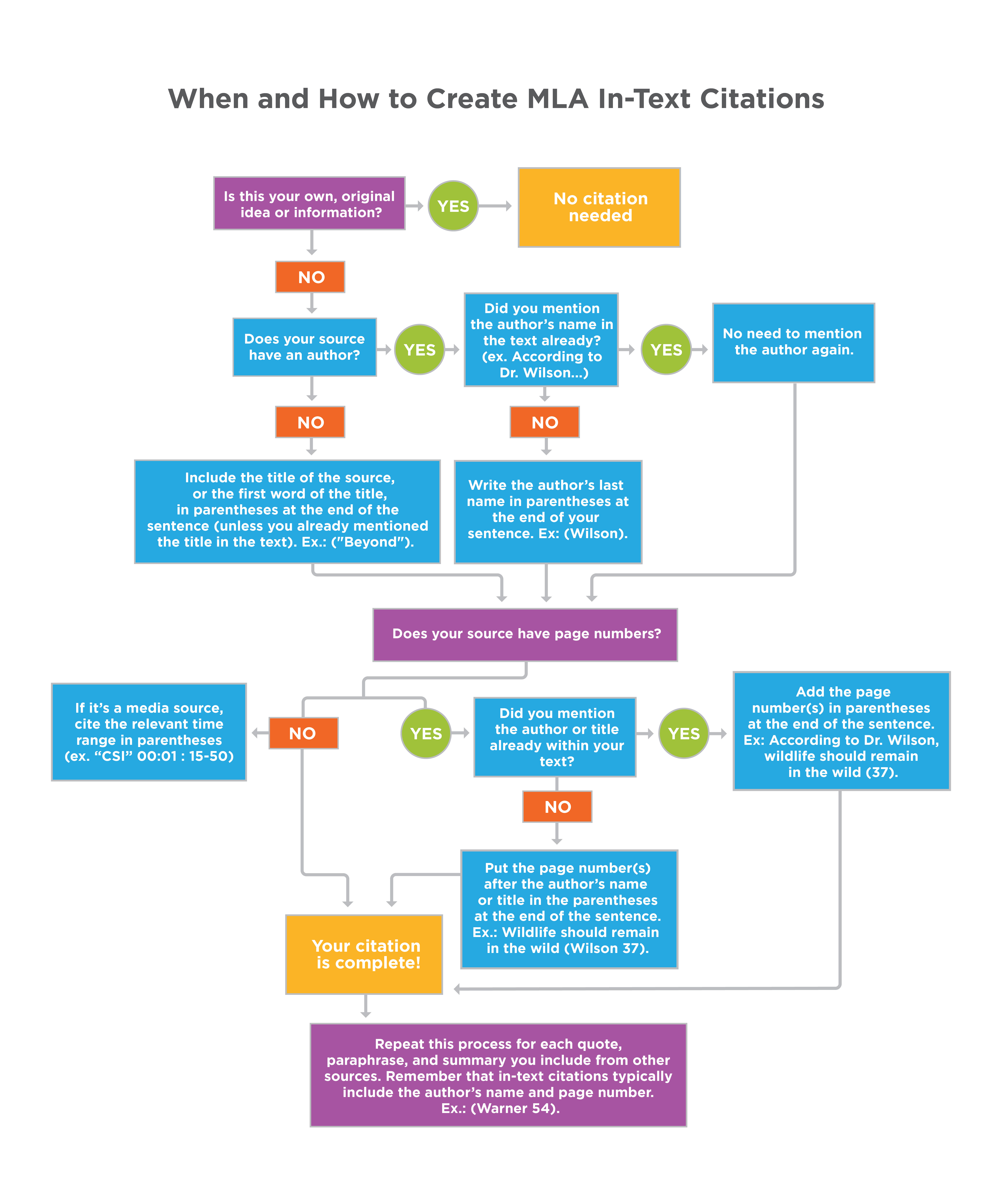Because the use of in-text citations will be so integral to your writing processes, being able to instantly craft correct citations and identify incorrect citations will save you time during writing and will help you avoid having unnecessary points taken off for citation errors.
Here is the standard correct in-text citation style according to MLA guidelines:
Take a moment to carefully consider the placement of the parts and punctuation of this in-text citation. Note that there is no punctuation indicating the end of a sentence inside of the quotation marks—closing punctuation should instead follow the parentheses. There is also no punctuation between the author’s last name and the page number inside of the parentheses. The misplacement of these simple punctuation marks is one of the most common errors students make when crafting in-text citations.

Include the right information in the in-text citation. Every time you reference material in your paper, you must tell the reader the name of the author whose information you are citing. You must include a page number that tells the reader where, in the source, they can find this information. The most basic structure for an in-text citation looks like this: (Smith 123).
So, let’s say we have the following quote, which comes from page 100 of Elizabeth Gaskell’s North and South: “Margaret had never spoken of Helstone since she left it.”[1]
The following examples show incorrect MLA formatting:
| “Margaret had never spoken of Helstone since she left it.” (Gaskell 100) | Incorrect because the period falls within the quotation marks |
| “Margaret had never spoken of Helstone since she left it” (Gaskell, 100). | Incorrect because of the comma separating the author’s last name and the page number |
| “Margaret had never spoken of Helstone since she left it” (Elizabeth Gaskell 100). | Incorrect because the author’s full name is used instead of just her last name |
| “Margaret had never spoken of Helstone since she left it” (North and South 100). | Incorrect because the title of the work appears, rather than the author’s last name; the title should only be used if no author name is provided |
The following example shows correct MLA formatting:
However, there are exceptions to the above citation guideline. Consider the following format of an in-text citation, which is also formed correctly.
Elizabeth Gaskell’s narrator makes it clear that “Margaret had never spoken of Helstone since she left it” (100).
Do you notice the difference between this citation format and the format of the first example? Unlike the first example, this citation does not list the author’s last name inside the parentheses. This is because the last name is included in quotation’s introduction, which makes the identity of the author clear to the reader. Including the author’s last name again inside of the parenthesis would be thus redundant and is not required for MLA citation.
The same rule about inclusion of the author’s last name applies for paraphrased information, as well, as shown in the following example:
In this paraphrase, the author’s last name precedes the paraphrased material, but as in the case of quotation integration, if the author’s last name is not described in the paraphrase then it is required inside of the parentheses before the page number.

Being more compliant with MLA in-text citation guidelines will become easier if you review these examples and the citation rules on which they rely.

In-text citations are often parenthetical, meaning you add information to the end of a sentence in parentheses. But if you include that necessary information in the language of the sentence itself, you should not include the parenthetical citation. This example shows you proper uses of in-text citations.
When to Use a Block Quotation
A typical quotation is enclosed in double quotation marks and is part of a sentence within a paragraph of your paper. However, if you want to quote more than four lines of prose (or three lines of verse) from a source, you should format the excerpt as a block quotation, rather than as a regular quotation within the text of a paragraph. Most of the standard rules for quotations still apply, with the following exceptions: a block quotation will begin on its own line, it will not be enclosed in quotation marks, and its in-text citation will come after the ending punctuation, not before it.
For example, if you wanted to quote the entire first paragraph of Lewis Carroll’s Alice in Wonderland, you would begin that quotation on its own line and format it as follows:
Alice was beginning to get very tired of sitting by her sister on the bank, and of having nothing to do: once or twice she had peeped into the book her sister was reading, but it had no pictures or conversations in it, ‘and what is the use of a book,’ thought Alice, ‘without pictures or conversations?’ (Carroll 98)
The full reference for this source would then be included in your Works Cited section at the end of your paper.
The entire block quotation should be indented one inch from the left margin. The first line of the excerpt should not be further indented, unless you are quoting multiple paragraphs—in which case the first line of each quoted paragraph should be further indented 0.25 inches. As should the rest of your paper, a block quotation in MLA style should be double-spaced.
Block Quotations
Watch this video from Imagine Easy Solutions for more information on formatting block quotations.
- Gaskell, Elizabeth. North and South. Oxford UP, 1973. ↵